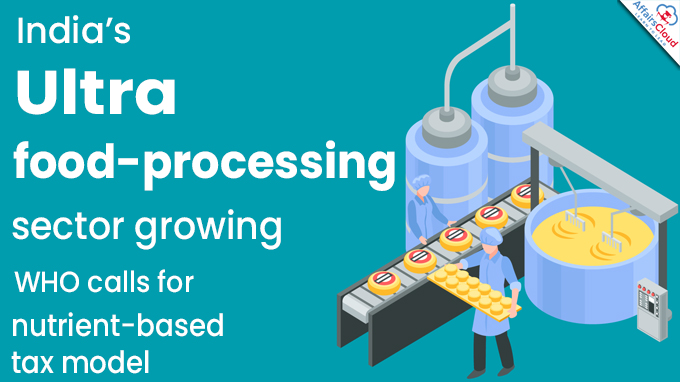 According to the World Health Organization (WHO)’s report titled “Growth of ultra-processed foods in India- An analysis of trends, issues and policy recommendations”, India’s Ultra-Processed Food Sector grew at a Compound Annual Growth Rate (CAGR) of 13.37 % in retail sales value from 2011 to 2021.
According to the World Health Organization (WHO)’s report titled “Growth of ultra-processed foods in India- An analysis of trends, issues and policy recommendations”, India’s Ultra-Processed Food Sector grew at a Compound Annual Growth Rate (CAGR) of 13.37 % in retail sales value from 2011 to 2021.
- This report has been developed by the WHO Country Office for India in collaboration with the Indian Council for Research on International Economic Relations (ICRIER).
- The report called for a nutritional transition to a healthier lifestyle.
What is Ultra-Processed Food?
As per the British Heart Foundation, Ultra-processed foods are items with long shelf lives that usually contain five or more ingredients, including preservatives, emulsifiers, sweeteners, and artificial colors and flavors.
Highlights from the Report:
i.The report has analysed five popular categories of ultra-processed foods in India, chocolate and sugar confectionery; salty snacks; beverages; ready-made and convenient foods; and breakfast cereals.
ii.The report highlighted the requirement of policy interventions to halt this rising trend of ultra-processed food in order to prevent India from facing an obesity epidemic similar to certain Western nations.
iii.Notably during the COVID-19 Pandemic, Indian ultra-processed food sector’s annual growth rate declined sharply from 12.65% in 2019 to 5.50% in 2020.
- However, during 2020-2021, a significant rebound in sales occurred with 11.29% growth.
iv.In retail sales volume from 2011 to 2021, beverages had the largest share, followed by chocolate and sugar confectionery, and ready-made convenience food at 2nd and 3rd place.
- Within beverages, concentrates/squashes dominated with 77% in 2021 (down from 80% in 2011), followed by soft drinks/concentrates at 13%, and juices at 9%.
v.In 2021, sweet biscuits share was more than 43% of the chocolate and sugar confectionery market in retail sales value due to their affordability, convenient storage, and extended shelf life.
vi.Retail sales of salty snacks increased at a rate of 16.78% from 2011 to 2021.
- High salt content can make consumers vulnerable to hypertension and heart and kidney diseases, etc.
Key Recommendations by Report:
The report have recommended actions for India to achieve nutritional security and meet United Nations (UN) Sustainable Development Goals (SDG) by 2030:
i.The report highlighted that the advertising and marketing regulations should reduce the targeted efforts to market and advertise products like sweet biscuits to childrens.
ii.The report also stated that Food Safety and Standards Authority (FSSAI) in consultation with stakeholders, should establish a clear HFSS (High Fat, Sugar and Salt) food definition.
- Following this, Goods & Service Tax (GST) Council should align tax structures with HFSS Food definition. A nutrient based tax model will implement higher taxes for products that have fat, sugar, and salt beyond the recommended levels and lower taxes for healthier options.
iii.There should be strengthening of existing policies, and development of comprehensive national nutrition policy for undernutrition and overnutrition, with defined objectives, goals, and targets.
iv.Tax should be increased on non-packaged and unlabelled foods, which is currently taxed at 5% under GST regime.
v.Zero-sugar carbonated drinks should not be classified under the same GST category in line with carbonated drinks.
Recent Related News:
i.According to the ‘Hunger Hotspots: FAO-WFP early warnings on acute food insecurity, June to November 2023 Outlook’ report released on May 29, 2023, by the United Nation (UN) agencies of Food and Agriculture Organization (FAO) and the World Food Programme (WFP), globally Hunger is set to worsen in 18 ‘hotspots’ comprising a total of 22 countries including the regions in India’s neighbours countries of Pakistan, Afghanistan and Myanmar.
ii.According to the International Labour Organisation (ILO)’s 11th edition ‘World of Work’, the global unemployment is projected to fall below pre pandemic levels to 191 million, corresponding to an unemployment rate of 5.3% in 2023.
About World Health Organization (WHO):
Director-General– Dr Tedros Adhanom Ghebreyesus
Headquarters– Geneva, Switzerland
Establishment– 1948




